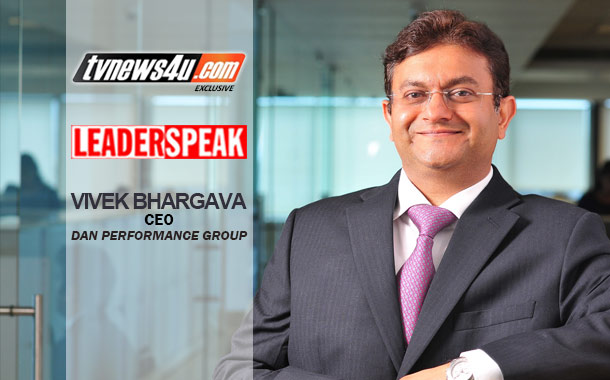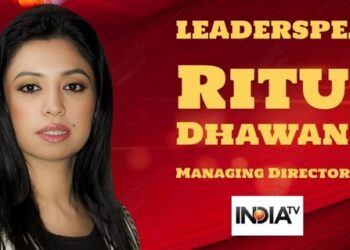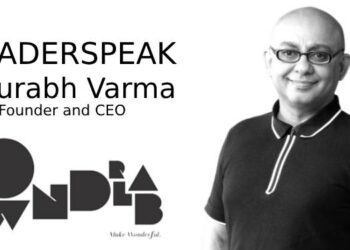A digital marketing veteran with two decades of experience, Vivek Bhargava is Chief Executive Officer of DAN Performance Group. He is a digital entrepreneur and a respected digital evangelist who heads all digital performance agencies of Dentsu Aegis Network. He believes that ‘digital’ is much more than a mere marketing medium
Vivek wore the entrepreneurial hat early on – in 1997, when he founded Communicate 2, which, 15 years later, in 2012, joined hands with Iprospect of Denstu Aegis Network. He has encouraged young entrepreneurs by investing in various companies such as Foodebaba, Awesummly, Chimera, Eon energy and Box.ai.
Vivek believes Indian CEOs can utilize the power of digital to transform their businesses and grow at an exponential rate. The adoption of digital can only happen from the senior management and hence it is imperative that senior managements get digital-savvy.
TVNews4u.com’s Yohan PC caught up with Vivek Bhargava for a freewheeling chat about his digital knowledge and expertise, and his views on the digital space in India, the way forward, and more.
Four companies and just one P&L? Tell us about the structure and function of DAN Performance Group.
DAN Performance Group consists of four companies, iProspect, Merkle Sokrati, SVG Media and the latest addition to this group is DAN Consult. Each of these entities has a CEO and all of them report to me. This the basic structure of the DAN Performance Group. Each of these companies have teams of about 250-300 people.
DAN Consult has a strategy team that coordinates with the entire DAN Group. As DAN is the only network in the world that has one P&L, our objective is to enable ourselves to harness the capabilities and competence of every single individual in the 3,600-member team and deliver value to our clients. DAN Consult is what helps us harness the expertise and capabilities of every team member in the network to solve the challenges of our clients.
During your two-decade journey, what transformations did you witness in the digital ecosystem as it continued to gain prominence in the recent times?
In 1997, I started a company called, Communicate 2.
The early days of digital were just supporting some of the conventional mediums. The digital we used to do in those days was adding a CD-ROM to a brochure or creating microsite for a client. Nobody felt the need for digital. A client who had 5 lakh rupees left out of a campaign with a budget of 10 crores, would want to spend that money on digital in order to get a tick mark.
Thereafter digital started gaining importance, it started delivering value in terms of media and hence, it became a part of the media mix itself. One started planning for digital the same way how one would plan for Print or TV and it became an important aspect of the media mix. With time, digital investments rose to double digits.
What big changes did you witness in the recent past?
In the last couple of years, there have been a couple of big changes in the digital industry.
Firstly, digital has become a very effective platform for brand communication. People are putting large chunks of their branding budgets on digital. In many cases, people have started putting 100% of branding budgets into digital.
Secondly, senior management which usually comprises of the CIOs and CEOs have realized that digital is something that can transform their businesses. They are spending a lot more time and effort in understanding digital.
I think this transformation is amazing because people like me are getting access to board members and promoters of companies who are starting to adopt digital in their day to day life. We are getting access to the sort of people that can change and transform an entire company.
I think this change of perception, has happened in the last few years. Today digital is the age we are living in and almost every single organization can transform itself by harnessing digital effectively.
As a digital evangelist, how have you worked to enlighten clients on the importance of digital marketing? Where do we stand today, when we compare ourselves with developed international markets?
The only way to grow digital in the country is to educate people. The more they understand and start using digital, the better it is for the industry, and that has been one thing for which DAN Performance Group have been thought leaders for.
In the past twenty years, I have done hundreds of workshops for eight hours at a stretch. We would also do workshops for other agencies where we would usually not get paid, or get measly sums. These workshops have given us lots of friends and they have picked our brains to learn digital from us
The main difference between India and abroad is the digital fitness of the companies. If you take the top 100 Boards of India, I would be surprised if any of their Boards have people who are below the age of 50.
If a simple survey is conducted with some very basic questions like: How many of those Board Members would have ever booked an Uber? How many of them have actually bought anything on e-commerce? How many of them have actually subscribed to a Netflix or a Hotstar or an Amazon Prime Video or the other service where they actually paid for content? How many of them have used an Alexa or a Google Home? How many of them have even seen what VR or AR is? I will be surprised if more than 25% of the Board Members of the top 100 companies of India have done any of these basic digital-savvy activities.
So I think the biggest difference between India and abroad is, here, it is the senior-most person of a company who is the last person to learn technology. When CEOs and MDs lead the way with digital and technology, India actually could grow exponentially.
If you don’t digitally enable the seniors, it will be a huge challenge for companies. The youth will take care of technology for themselves, but the seniors need to get trained. They are almost scared of using technology. They’ve been inherently taught that a mistake committed is irreparable.
A television person could get fired if his campaign fails, but you can experiment with digital. To understand that failures are okay is also digital fitness. Using data to make decisions is digital fitness. It’s not about SEO or SMO. It’s about understanding how one could prosper in the digital world, and how one should change the culture of an organization and drive them to become digital-savvy.
Take Mr Anand Mahindra of the Mahindra Group for instance. He constantly tweets, and almost every single senior manager of the Mahindra group is now on Twitter because they simply don’t have a choice. However, I would love to know how many the board members from the Mahindra group actually take an Uber once a month? They are in the automobile business and this one of the biggest threats they are facing. This will help them understand the threats and opportunities that lie in the market. 
Brand safety and data privacy issues — what is the way forward for digital marketers?
Data privacy is a larger issue and the impact of data privacy on the advertising industry is significantly lesser. For instance when someone hacks into the systems of a hospital, that data breach would have serious implications, but when a marketer shows a consumer an advertisement that has been created after studying and analyzing consumer data, then the implication of such data privacy is not as significant as the hack. It’s all about appropriate advertising, and marketers use the consumer data to understand the relatability of an advertisement to a set consumer base.
Today all companies across the spectrum are using data to influence the consumer — banks have business intelligence and data mining departments which look at the consumer’s transaction data and offer loans and other banking services. That is something that has always been there.
Even when you walk into a physical retail shop the manager is going to look at you and sort of decide whether you need a personal shopper or not, whether you are going to buy something or not. I was recently sitting with a promoter of a leading retail chain, and the biggest challenge they are facing is that if there are a hundred people in the store and they have only a ten percent shopper’s rate, how do they identify those ten people who are actually going to buy something?
The same situation 20 years ago would have presented an easier scenario because a person who would be dressed in a suit would be more affluent and would have had more purchasing power than the others. Nowadays, a person in a black shirt and jeans may be a bigger shopper than that person in the suit, so the question now is, ‘How does one identify?’
We came out with a simple solution and trained the salesmen to identify the jeans brand worn by any prospective customer, by simply observing the pocket.
Just imagine: in the absence of digital intelligence, you look at a person and decide whom you should help and who you shouldn’t. Another way is to observe the shoes of a customer and identify the brand to understand the purchasing power.
At the end of the day, a marketer has used data to show you advertisements and given the consumer a choice: to click on an ad and influence the consumer to purchase a product or service. It’s not as big as an issue as it has been made out to be!
- Facebook has stopped giving access to third parties in the aftermath of ‘Catalyst Analytical saga’. Will it impact the Industry?
In the long run, it can impact the industry. According to me, Facebook itself will use that data to give ads. They will figure out ways where they can show ads on other networks without giving complete access to data to those networks.
Having said that, consumers would prefer advertising based on their profile. I feel that there is nothing wrong using a person’s data to show them more relevant advertising. It is useful to the advertiser as well as to the consumer.
The reason why Facebook’s users have not decreased is because people have realized that if this is the amount of influence Facebook has, then it is great to be on Facebook.
As a consumer if you shut off Facebook, that is completely your prerogative, but if you are not doing that, the marketers know that Facebook is an interesting medium which can be very powerful. So I am not sure if this is detrimental to Facebook’s interests or beneficial for Facebook.
What are the notable challenges ahead for digital marketing agencies?
There are lots of challenges. Digital is growing exponentially and the number of people in the industry is limited. The speed at which we are growing, I think it’s a big challenge to scale up the talent to that level of growth. The demand is for a hundred, and there are only twenty in supply. So we really need to train a lot more people to do digital.
Promoters and CEOs are evincing interest in digital and hence they need senior digital people to come to talk to them and help them transform their business. The sad part here is that there aren’t enough senior people in digital industry at this point. This is where DAN Consult comes in; we get the senior people access to senior digital leaders in the DAN network.
A lot of work that agencies do consists of mechanical, reporting tasks etcetera, which is going to get automated. This will really dramatically affect the industry. The challenge would be, how do we navigate to that world where all the automation we do replaces 30 to 40 percent of the work that our teams do currently, and how do we deploy them into things which machine learning or AI cannot do?
Tell us some of the most satisfying campaigns that DAN Performance Group has delivered to its clients in the recent past?
DAN Performance group is a combination of Iprospect, Merkle Sokrati, SVG Media and DAN Consult.
Talking about Merkle Sokrati, some their commendable campaigns are Swiggy and Ebay.
SVG Media has done a fabulous job for the Indian Badminton League and some of the middle-east clients like noon.com.
The campaign for Kotak, by Iprospect, is one of the memorable campaigns. They also did outstanding work for ICICI Bank and Raymond. The campaign for Amfi is a big one for Iprospect and we are very proud of our work.
More than 80% of digital display ads will be bought programmatically in 2018. How prepared is DAN group for this mode of ad buying by its clients, or factoring it in to the bigger DAN group plans and strategies for its clients?
DAN Performance Group is well prepared, and the most advanced in tech terms, than any other group in the world. We have tools that completely automate the entire process of buying ads and optimizing them.
We have created automated AI tools in India which are now being used in almost 15 markets across the world. Markets such as UK, USA, Australia, Japan and other developed countries.
AI is made up of data, algorithm and machine learning, and all our tools actually use these three things to create a completely automated process of managing this information and in most cases helping the man perform better with the help of a machine. So our belief is that it is not going to be man vs. machine; it is going to be man and machine.
Organizations which will get the competent advantage are the ones that have better machines, but have men who know how to make better use of machines. This is our approach of effectively utilizing the power of these machines. That is where our competitive advantage is going to be, and we are far ahead of everyone at this space.
There are two kinds of wastage: wilful and inadvertent. Wilful, of course, is ad fraud. What checks would you recommend should be in place against ad fraud?
There are a lot of third-party softwares we use. DAN Group has a complete end-to-end attribution system called Adcelerate. It does complete attribution from a display to a search, to a mobile ad, and you can almost know your cost of acquisition across every single channel. This makes it easier to identify any ad fraud. It is also the most sophisticated attribution system that any network owns in the world.
What kind of measurement and reportage does DAN Performance Group have in place to ensure that there is clarity and strategy while buying or employing platforms, and exactitude and insight while reporting to clients?
DAN Performance Group has a lot of proprietary tools. Merkle Sokrati has a complete reporting engine, As soon as a new client is on board, he gets his interface with access to complete measurement and reportage on real-time basis.
Adcelerate is a very effective attribution and measurement system. We tweak and customize all our proprietary systems according to the needs and requirement of our clients. Sometimes it’s reporting of the existing campaigns sometimes it’s also getting insights.
We also have something called DAN Explore: with some basic details such as domain name, industry and target, it takes inputs from another tool called consumer connect system, Facebook, BARC and some of the other social media tools we have access to and creates a complete insights dashboard of which consists of the target audience, and the insights we have about them.
These are automation measures done based on past performance of the market and other campaigns from the data available freely and then creates insights using that.
The Consumer Connect System has about 14,000 respondents across 30 countries, which is by far, the most sophisticated and comprehensive consumer survey in the world for the media industry.
Does the Digital Industry have enough talents to meets the demands of the market?
There is an immediate need of highly trained people in the digital space. Having said that, we at DAN Group are very fortunate to have a great team of hardworking and committed people. We make sure that our teams get exposed to new clients almost every month. There are so many things to be learnt that it takes a good amount of time for an individual to get that experience where a person does strategic consulting, communication etc. This is one of the biggest challenges we face; how does one retain people for the longest time possible.
At the senior level we have got a great retention rate. At the junior level we have realized that if an individual spends a minimum of two years with us, they get a pretty large jump in salary. All deserving people get regular jumps and we ensure their growth is on a fast track. Individuals who want to leave are usually those with whom we are okay to let go.



















